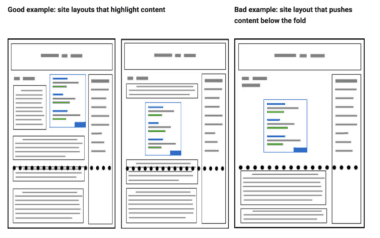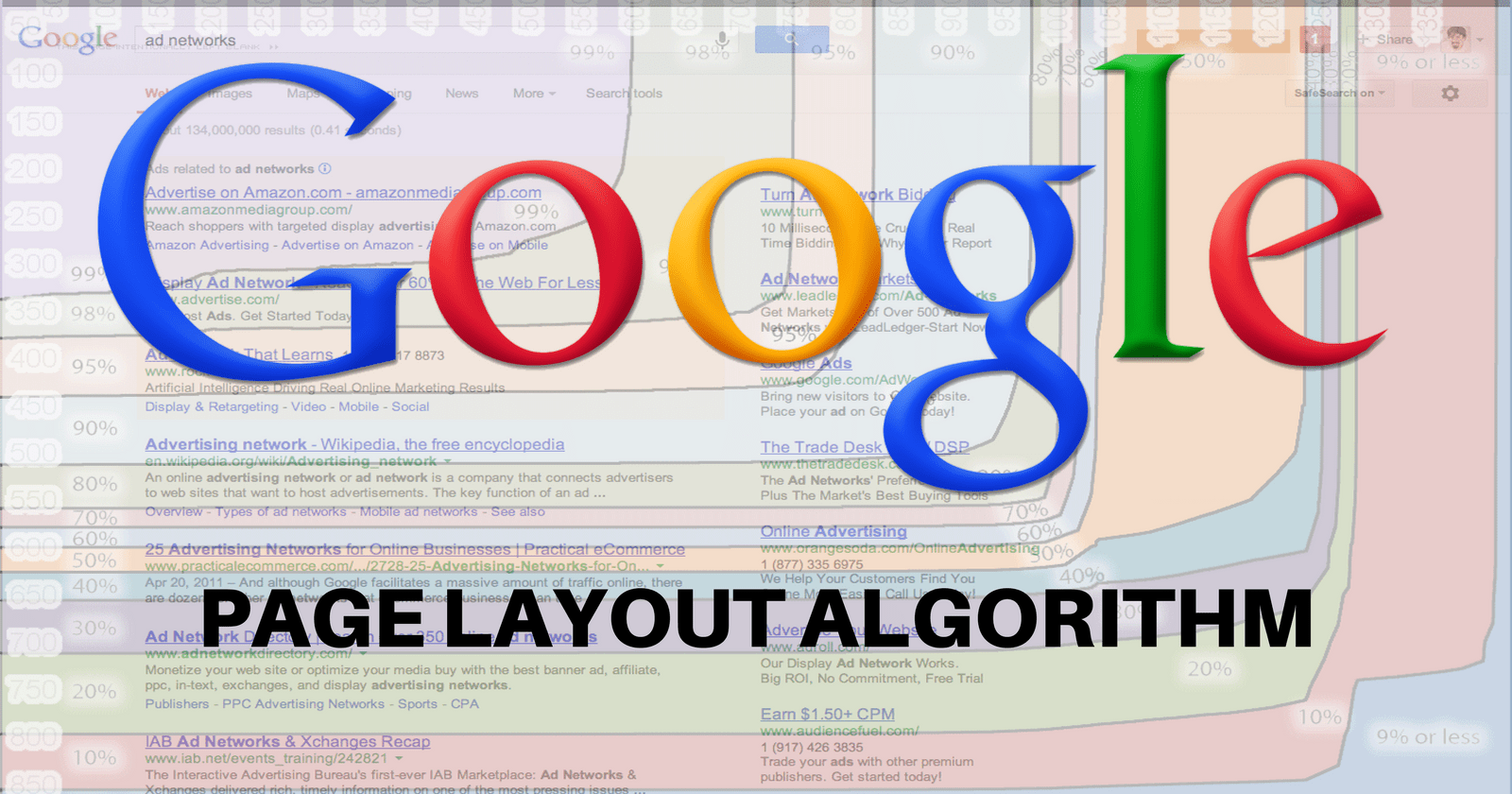There are plenty of rabbit holes to fall into when it comes to Google algorithm updates.
One of my favorites (after the unsolved mystery of Fred) involves the 2012 Google algorithm update on page layout and the above-the-fold movement.
Like the JCPenney link building scandal, there are still plenty of people who talk about this Google algorithm update — you just have to know who to ask. But you don’t have to go digging into the archives, we’ve got you covered here.
This post will tell you everything you need to know about Google’s page layout algorithm, how it has evolved over the years, and what it means to you now.
What Was the Google Page Layout Algorithm?
The arrival of a high-quality user experience and more sophisticated on-page SEO might have felt premature in the wake of 2011 Panda updates, but Google made it official on January 19, 2012: the page layout algorithm was here.
The page layout algorithm update targeted websites with too many static advertisements above the fold. These ads would force users to scroll down the page to see content.
Google said this algorithm would affect less than 1 percent of websites. But, the 1 percent of those sites affected were forced to design a better user experience.
This update didn’t include pop-ups or overlay ads.
Page Layout/Above the Fold Google Algorithm Update Timeline
Here’s a quick snapshot of how the algorithm has changed over time:
1. January 19, 2012: Page Layout Algorithm Launched
Google introduced the first-page layout algorithm update, also known as “Top Heavy” or the above the fold algorithm update, impacting sites that showed too many ads above the fold.
2. October 9, 2012: Page Layout Algorithm Update
Matt Cutts, then head of Google’s webspam team, announced on Twitter that the page layout algorithm had been updated. It affected 0.7 percent of English queries. The update also gave an opportunity to websites hit by the first Google algorithm rollout to potentially recover.
Minor weather report: Update of http://t.co/kcDiRUjc launching today. ~0.7% of English queries noticeably affected.
— Matt Cutts (@mattcutts) October 9, 2012
3. February 6, 2014: Page Layout Algorithm Refresh
Google released a refresh of the page layout algorithm on February 6, 2014. Cutts didn’t mention the impact on search results this refresh would have on websites. While it was a refresh, it appeared Google simply reran the algorithm and updated its index.
SEO folks: we recently launched a refresh of this algorithm: http://t.co/KKSXm8FqZW Visible to outside world on ~Feb. 6th.
— Matt Cutts (@mattcutts) February 10, 2014
4. November 1, 2016, Automated Algorithm
John Mueller of Google announced in a Google Webmaster Hangout at the 48-minute mark:
“That’s pretty much automatic in the sense that it’s probably not live, one-to-one. We just would recalled this, therefore, we know exactly what it looks like. But it is something that’s updated automatically. And it is something where when you change those pages, you don’t have to wait for any manual update on our side for that to be taken into account.”
After Mueller’s comment, it seemed clear that Google would pick up on changes to your website and adjust rankings automatically after crawling your site.
Google’s Gary Illyes also confirmed the page layout algorithm is still a big deal, in March 2017:
yes, it’s still important
— Gary “鯨理” Illyes (@methode) March 14, 2017
Websites Impacted by the Page Layout Algorithm
With four updates to the page layout algorithm, it might seem like a significant change, but less than 1 percent of sites were affected by each of the updates.
These changes only affected people that had an excess of ads, to the point where user experience was weak, and it might benefit their site to re-think their web design.
Cutts explained it further:
“This algorithmic change does not affect sites who place ads above-the-fold to a normal degree, but affects sites that go much further to load the top of the page with ads to an excessive degree or that make it hard to find the actual original content on the page.”
As a website owner, I can see where some people might have been upset. When it’s your page, with your ads, you’d think you should be able to organize it however you want and not be penalized.
Besides, placing ads is how many of us keep our sites profitable. Lots of prominent ad spots will pull in more revenue…But, at what cost?
Some members of the WebmasterWorld forum saw an impact:
One forum member stated they were hit by the first algorithm update on February 7, 2012 and saw a 40 percent drop in traffic. They shared this image:

Another member said it took them two years to recover from the first algorithm update.
The truth is that people won’t want to visit a site if they feel berated with ads. They’ll get frustrated and look for whatever they were searching for – whether it’s birthday party ideas or expert golf advice – somewhere else.
Companies would instead put ads below the fold on a popular site (or fight for only a few spots at the top) then place them as one of many banner ads on a low-traffic site.
This change benefited the site owners, the ads, and the viewers.
Page Layout Algorithm Recovery
What is it about Google algorithm updates that send all of our thoughtfully crafted, tried-and-true, SEO strategies out the window?
It’s easy to get caught up in the mass hysteria of website redesigns, content rewrites, only to suffer from a penalty months later. All because of one Google algorithm update?
While only 1 percent were affected, what if you were in that 1 percent? Let’s take a look at recovering from the page layout Google algorithm update properly.
First things first, the above-the-fold area depends on what screen resolution your audience is using.
For example, a user on their phone would see a different above-the-fold space than if you’re looking from your laptop.
So, before removing any above-the-fold ads, use the Screen Resolution Tester Chrome extension. (Fold Tester is another free tool you can use to test your layout visually on the desktop.)
You can also review Google Code’s blog post that dives deep into the above-the-fold screen tests.
Google also provides an image to display what Google is looking for in the above-the-fold area:

If you do get hit with a penalty due to too many ads above the fold, you’ll have to wait for the Googlebot to recrawl your website. The good news is now that Google makes updates in real-time, you no longer have to wait until the next algorithm refresh happens.
The Final Impact of the Page Layout Algorithm
Dealing with a Google algorithm change like the page layout update can feel like falling into an abyss of constant web design changes over and over again. While I’ll be the first to admit that this update may have seemed harsh, Google’s message was clear: They value user experience.
Removing ads above-the-fold shouldn’t involve reducing your revenue. And, if I’m digging deep into the intent behind this algorithm update, it seems Google was laying the foundation for a mobile-only index.
Google instructed us to review ads above-the-fold on all screen resolutions, including mobile. With a smaller screen resolution on mobile and tons of ads, users would have to scroll down 5 to 6 times more than on a desktop. Without ads above-the-fold, users receive a better experience on desktop and mobile.
The truth of the matter is: Google’s page layout algorithm update was made for the user, not the webmaster. It’ll pay off in the long-run to be choosy about your advertisers.
Post-page layout algorithm change, the best sites that focus on the balance between ads and content, win.
We know, especially now, that there is a fine line between keeping a site profitable and keeping users engaged. This algorithm may have gone into effect years ago, but the lessons it taught us – and the problems it fixes – are still relevant.
Image Credits
Featured image: Created by Danny Goodwin
In-line post #1: WebmasterWorld
In-line post #2: Google




